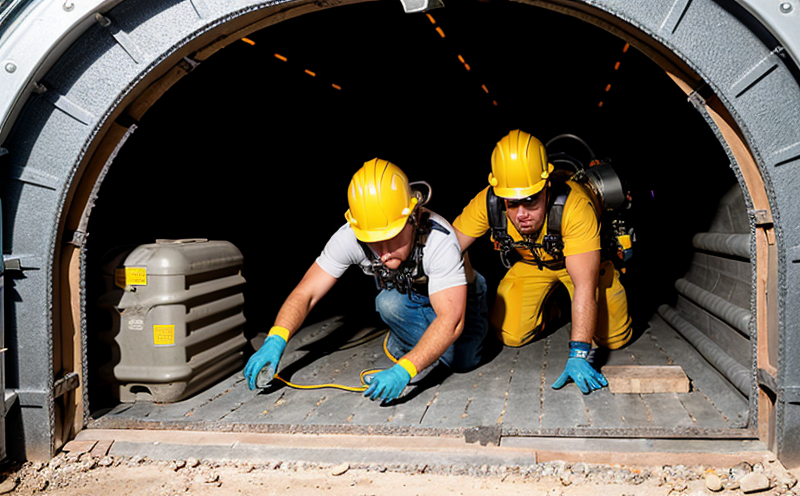Confined space entry inspection
The process of confined space entry inspection is critical in ensuring worker safety and compliance with regulatory requirements. Confined spaces are areas that are large enough to bodily enter and have limited or restricted means for entry and exit. These environments can pose significant hazards such as hazardous atmospheres, engulfment risks, heat stress, or other physical dangers. The primary goal of a confined space inspection is to identify potential hazards before any personnel enters the space.
The process typically involves several key steps: pre-entry planning, hazard identification, atmospheric testing, and personal protective equipment (PPE) assessment. Pre-entry planning includes assessing the type of work that will be conducted in the space, identifying all potential hazards, and determining the appropriate safety measures to take. Hazard identification focuses on recognizing the specific risks present in a particular confined space, such as flammable gases or low oxygen levels.
Atmospheric testing is performed using calibrated instruments to measure parameters like oxygen content, combustible gas concentrations, and toxic gas levels. This ensures that the atmosphere inside the confined space meets safe working conditions before entry. Proper PPE assessment involves selecting appropriate clothing and equipment such as respirators, harnesses, and communication devices tailored for the specific risks present in the environment.
The inspection team must also ensure they have all necessary permits and authorizations from relevant authorities, including a permit to work (PTW). This document details the precautions that need to be taken during entry into the confined space. Compliance with local regulations and industry standards is essential for conducting safe inspections. For instance, in many regions, OSHA and other bodies provide guidelines on how to conduct these inspections effectively.
During an inspection, it's important to maintain thorough documentation of all findings. This includes detailed records of atmospheric tests conducted, any issues identified within the confined space, and steps taken or recommended for mitigating those risks. Regular updates and reviews of these records help ensure ongoing compliance with changing conditions over time.
In conclusion, a comprehensive approach to confined space entry inspection is vital in safeguarding worker health and safety while meeting regulatory requirements. By carefully planning each step of the process, using reliable measurement tools, and adhering strictly to best practices outlined by recognized organizations like OSHA or ANSI Z39-14, businesses can protect their employees from potentially life-threatening situations.
Why It Matters
The importance of confined space entry inspection cannot be overstated. Regulatory compliance is just one aspect; the broader implications extend far beyond mere adherence to legal standards. Properly conducted inspections contribute significantly to reducing workplace injuries and fatalities, which directly benefit both employers and employees.
- Reduces Workplace Injuries: By identifying potential hazards early on through thorough inspection processes, risks can be mitigated or eliminated entirely before workers enter the confined space.
- Improves Employee Safety: Ensuring that all necessary precautions are taken during entry into a confined space helps prevent accidents and injuries associated with these environments.
- Promotes Compliance: Adhering to local regulations not only avoids penalties but also demonstrates commitment to maintaining high standards of safety within the organization.
In addition to these direct benefits, there are indirect advantages as well. For example, improved worker morale and confidence in their working environment contribute positively towards overall productivity and job satisfaction. Moreover, by fostering a culture of safety throughout an organization, companies may see reduced turnover rates and lower healthcare costs due to fewer accidents.
Ultimately, the value of conducting thorough confined space entry inspections lies not only in avoiding immediate penalties but also in creating safer working conditions that promote long-term sustainability within your business operations.
Environmental and Sustainability Contributions
Conducted inspections play a significant role in fostering environmental sustainability. By preventing accidents within confined spaces, we avoid unnecessary emissions from rescue operations or potential leaks that could contaminate nearby ecosystems. Additionally, by ensuring proper handling of materials and waste products, these inspections contribute to minimizing environmental impact.
- Reduced Emissions: Preventing incidents such as fires or explosions inside confined spaces reduces the need for emergency responses which often involve significant emissions from equipment like fire trucks.
- Mitigated Contamination Risks: Properly managed waste disposal and material handling minimize the risk of contaminants entering soil, water bodies, or air.
Furthermore, by promoting safe practices among employees, companies can encourage a culture of environmental responsibility that extends beyond just confined space entry inspections. This holistic approach to sustainability benefits not only the immediate work environment but also wider society.
Competitive Advantage and Market Impact
Implementing robust confined space inspection protocols offers substantial competitive advantages in today's market. Organizations that prioritize worker safety and compliance demonstrate a strong commitment to their employees' well-being, which can enhance reputation and attract top talent.
- Better Reputation: Companies known for maintaining high standards of workplace safety are more likely to be trusted by customers and investors alike.
- Talent Attraction: A safe work environment is increasingly seen as a key factor in attracting skilled professionals who prioritize their health and safety above all else.
Beyond reputation management, these practices contribute positively to operational efficiency. Safe working conditions reduce downtime associated with accidents or illnesses resulting from unsafe environments. This leads to increased productivity and profitability for businesses operating under such standards.
In conclusion, investing in comprehensive confined space inspection processes not only meets regulatory requirements but also contributes significantly to a company's overall success by enhancing its reputation, attracting talent, and improving operational efficiency.





